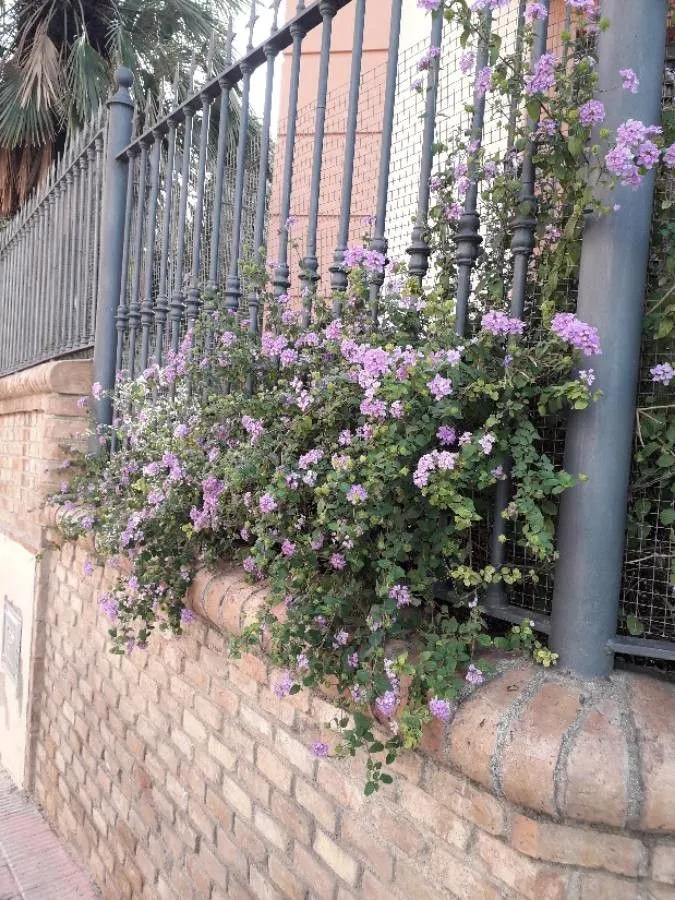
Author: (Spreng.) Briq.
Bibliography: Annuaire Conserv. Jard. Bot. Genève 7-8: 301 (1904)
Year: 1904
Status: accepted
Rank: species
Genus: Lantana
Vegetable: False
Observations: Bolivia to Brazil and N. Argentina
Purple lantana, scientifically known as Lantana montevidensis, is a vibrant and hardy flowering plant that belongs to the Verbenaceae family. First described in botanical literature in 1904 by the renowned botanist Briquet, Purple lantana has since been observed extensively across South America, ranging from Bolivia to Brazil and Northern Argentina.
Characterized by its sprawling growth habit, this evergreen perennial forms dense mats of foliage, making it an excellent ground cover. Its slender stems bear beautifully delicate blossoms, each cluster showcasing a charming array of small, tubular flowers. These flowers typically exhibit hues of lavender to deep purple, which not only add a splash of color to gardens and landscapes but also attract a variety of pollinators such as butterflies and bees.
Purple lantana is known for its resilience and adaptability to different growing conditions. It thrives in full sun and well-drained soils and is drought-tolerant once established. This makes it an ideal choice for gardeners seeking low-maintenance, ornamental plants that provide year-round interest.
In addition to its aesthetic appeal, Purple lantana has environmental benefits. It serves as an erosion control plant due to its ground-covering capabilities, helping to stabilize soil and prevent erosion in susceptible areas.
However, it is essential to manage Purple lantana appropriately in some regions, as it can become invasive under optimal conditions, outcompeting local flora. Regular pruning and monitoring can help maintain its growth within desired boundaries, ensuring that it remains a beneficial addition to the landscape.
Overall, Purple lantana (Lantana montevidensis) is a versatile plant that offers both beauty and functionality to various horticultural settings, from residential gardens to large-scale landscaping projects across its native range in South America and beyond.
Eng: trailing shrubverbena, creeping lantana, purple lantana, small lantana, trailing lantana, weeping lantana, wild verbena
Swe: liten eldkrona
En: Purple lantana, Wild verbena, Trailing lantana, Creeping lantana, Weeping lantana, Small lantana, Trailing shrubverbena
Ar: لانتانا مونتيفيديوية
Zh: 蔓马缨丹
Nl: Kruipende wisselbloem
Fi: Pikkutulikruunu
He: לנטנה לילכית
Sv: Liten eldkrona
Vi: Bông ổi tím
Taken Nov 6, 2017 by Creu Lopez (cc-by-sa)
Taken Nov 17, 2017 by 1 (cc-by-sa)
Taken Oct 21, 2017 by 1 (cc-by-sa)
Taken Oct 21, 2017 by 1 (cc-by-sa)
Taken Nov 6, 2017 by Creu Lopez (cc-by-sa)
Taken Feb 22, 2022 by Ariel Rodriguez (cc-by-sa)
Taken Jan 24, 2021 by Agustin A. Galeano (cc-by-sa)
Taken Apr 6, 2021 by Flozinha (cc-by-sa)
Taken Oct 21, 2017 by 1 (cc-by-sa)
Taken Nov 6, 2017 by Creu Lopez (cc-by-sa)
© copyright of the Board of Trustees of the Royal Botanic Gardens, Kew.
© copyright of the Board of Trustees of the Royal Botanic Gardens, Kew.
© copyright of the Board of Trustees of the Royal Botanic Gardens, Kew.
Taken Sep 14, 2021 by Trap Hers (cc-by-sa)
Taken Nov 23, 2015 by Tela Botanica − Hugo SANTACREU (cc-by-sa)
Taken Mar 5, 2020 by Kay Kay (cc-by-sa)
Taken Nov 6, 2017 by Creu Lopez (cc-by-sa)
Taken Oct 21, 2017 by 1 (cc-by-sa)
Taken May 1, 2019 by kavoi Timothy (cc-by-sa)
Taken Oct 16, 2018 by Helenne Kesenne (cc-by-sa)
Taken Mar 27, 2019 by Alejandro Guzmán (cc-by-sa)
Taken May 29, 2017 by Daniel Barthelemy (cc-by-nc)
Taken May 29, 2017 by Daniel Barthelemy (cc-by-nc)
Taken Jul 26, 2012 by EOL − Murry Gans (cc-by-nc)
Taken Apr 22, 2020 by Rémi Potier (cc-by-sa)
Taken Nov 27, 2020 by llagaria ismael (cc-by-sa)
Taken Nov 23, 2015 by Tela Botanica − Hugo SANTACREU (cc-by-sa)
Taken Nov 23, 2015 by Tela Botanica − Hugo SANTACREU (cc-by-sa)
Taken Nov 10, 2015 by Tela Botanica − shannti (cc-by-sa)
Growth habit>: Shrub, Subshrub
Family: Myrtaceae Author: (F.Muell.) K.D.Hill & L.A.S.Johnson Bibliography: Telopea 6: 402 (1995) Year: 1995 Status:…
Family: Rubiaceae Author: Pierre ex A.Froehner Bibliography: Notizbl. Bot. Gart. Berlin-Dahlem 1: 237 (1897) Year:…
Family: Sapindaceae Author: Koidz. Bibliography: J. Coll. Sci. Imp. Univ. Tokyo 32(1): 38 (1911) Year:…
Family: Asteraceae Author: A.Gray Bibliography: Pacif. Railr. Rep.: 107 (1857) Year: 1857 Status: accepted Rank:…
Family: Fabaceae Author: Medik. Bibliography: Vorles. Churpfälz. Phys.-Ökon. Ges. 2: 398 (1787) Year: 1787 Status:…
Family: Aspleniaceae Author: (Cav.) Alston Bibliography: Bull. Misc. Inform. Kew 1932: 309 (1932) Year: 1932…